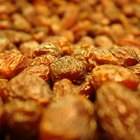
Grappa neutral flavor makes it a perfect candidate for iinfusing -- in fact, it has long been a tradition in Italy to do so. Start with a good quality grappa for your budget -- cheap versions have vicious petroleum-like flavors that no amount of infusing can cover up. Traditional ingredients used in Italy to flavor grappa include citrus fruits, cherries, figs, cinnamon sticks and chamomile. The process of infusing grappa is a relatively simple one, requiring only a few pieces of equipment and a little patience.
Step 1
Thoroughly wash your fruit and remove any debris from your herbs and spices.
Step 2
Prepare any fruits for bottling by removing pith, peels and pits. The basic rule is that if it's not something you would eat, do not use it to infuse your grappa. Cut or larger fruit, like pineapple, apples and citrus fruits, into one- or two-bite portions. Berries and smaller fruits can be left whole. Cut any large herbs or aromatics to fit inside your jar.
Step 3
Wash your glass jar, making sure to thoroughly rinse out any soap residue, as it can lead to off flavors. Loosely fill the jar with your selected fruit, spices or herbs.
Step 4
Fill the jar with grappa and seal it shut. For stronger tasting herbs and spices, such as cinnamon, you will want to want to use substantially less than you would fruit, as their flavors can be overpowering when infused.
Step 5
Store at room temperature and allow the grappa to infuse for 1 week to a month. Periodically taste the grappa to see if the flavors have melded to your liking.
Step 6
Strain and remove the ingredients from the grappa once you are happy with the flavor.
Step 7
Use a funnel to fill a thoroughly cleaned and rinsed resealable bottle with the infused grappa.
Step 8
Seal the bottle and store away from direct sunlight or heat sources. Infused grappa can be use as a mixer for cocktails, or can be drunk straight up, chilled or on the rocks as an aperitif or digestif.
Related Articles

How to Make Pickle-Infused Vodka

How to Infuse Vodka With Figs

How to Make Limoncello

How to Mix an Amaretto Sour Drink With ...

How to Make Fruit Punch With Sprite

How to Refresh Dried Fruits: Raisins

How to Freeze Fresh Watermelon

How to Make Strawberry Slushies

Does Brandy Freeze?

How to Make Your Own Essential Oil ...

How to Make Vodka Jelly

How to Store Smoothies in the Fridge
How to Ferment Watermelon

How to Make Blackberry Brandy

How to Make Sparkling Alcohol-Free ...

What Is a Good Substitute for ...

How to Keep Cucumber Juice Fresh

Good Things to Mix With Watermelon Vodka

How to Make Frozen Mixed Drinks With ...

How to Freeze a Prickly Pear Cactus
References
- Classic Spirits of the World; Gordon Brown
- Bon Appetit: Infuse Your Booze
- I-Italy: Grappa -- The Perfect Way to End a Meal
- Sauce Magazine: Bar Italia Keeps an Italian Grappa Tradition Alive
Tips
- When choosing fruits for infusing, opt for what is in season. Fruits that are at the height of their sweetness work best for infusing.
- Most grappas have an almost neutral flavor, and will pair with a wide variety of ingredients, so let your imagination be your guide.
- Use a bottle brush to clean your resealable bottle. They can be found at most homebrew supply shops, some wine retailers and many home supply stores -- especially those that carry higher-end wine glassware and decanters.
Writer Bio
Kurt Schrader has been writing professionally since 2005. He has also worked in the hospitality and travel industries for more than 10 years. Schrader holds a bachelor's degree in management, a master's degree in information studies and a Juris Doctor from Florida State University.
Photo Credits
Stockbyte/Stockbyte/Getty Images